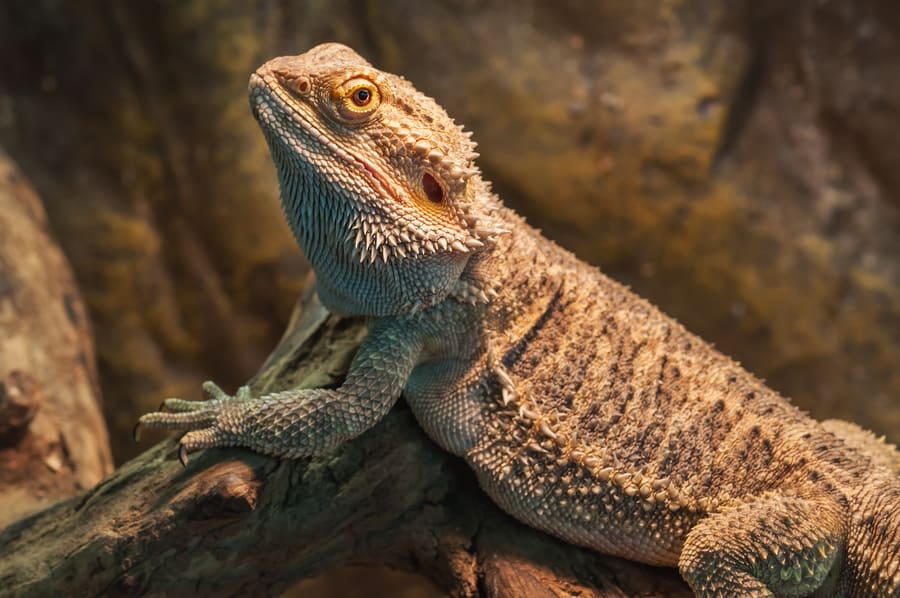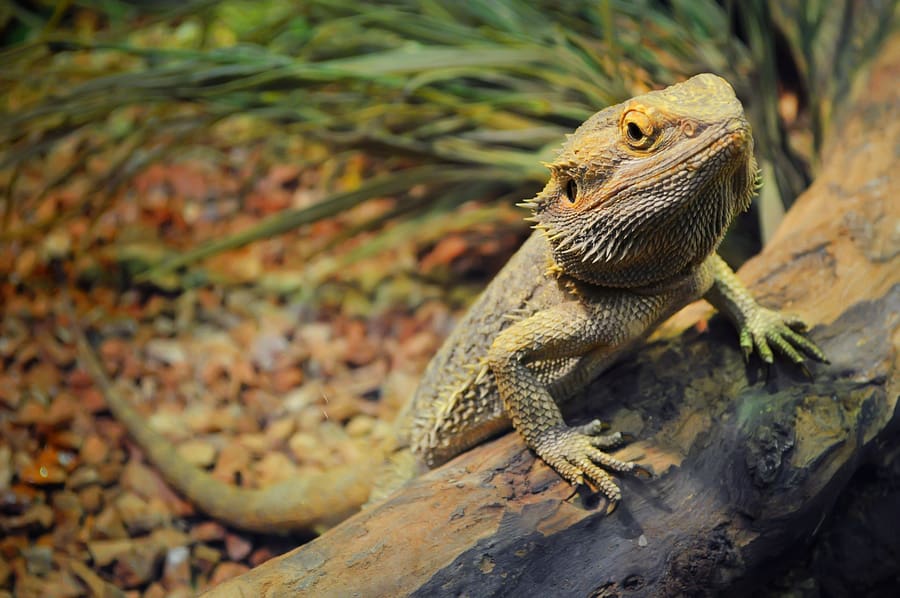
Bearded dragons are intelligent, playful, and easy-to-care-for lizards making them a popular pet. This is a lizard that is capable of forming deep attachments to the humans in its life, and it can be tempting to want to add another bearded dragon to keep your dragon company while you are at work.
Bearded dragons are solitary reptiles so pairing them is not recommended as they may fight and be stressed. If you are going to pair bearded dragons, pairing 2 females is the best way as they are most likely to coexist.
There are many important facets of bearded dragon behavior that must be considered before putting two bearded dragons in the same enclosure. Keeping several animals of virtually any species in the same enclosure unsupervised is always going to entail a certain amount of risk. For example, two dogs that are kept unsupervised in the same fenced backyard might have an unexpected disagreement and wind up injuring each other.
These same risks exist for bearded dragons, so before you decide to get a pair of bearded dragons or add another one to your pet’s habitat, you must consider the natural behavior of the species.
Should Bearded Dragons Be Paired Up?
Bearded dragons are not naturally social animals. In the wild, they live in separate territories. Females have smaller territories than males, and a male’s territory will include several females. He will breed with these females, but other than that, he generally won’t consider them to be his companions.
So bearded dragons have no natural “need” to be kept in social groups. They are perfectly fine being kept as single animals in their enclosures. Yes, bearded dragons do form close bonds with the people who care for them, but they do not necessarily form close bonds with each other.
Indeed, there are situations in which bearded dragons consider each other as competitors, and it could result in nasty fights.
Benefits & Drawbacks to Keeping Bearded Dragons in Pairs
The main benefit of keeping pairs of bearded dragons in the same enclosure is that you don’t need to buy another enclosure for your second bearded dragon. You will only need to clean out one enclosure instead of two,
The disadvantages are that one will need a large enclosure to house two bearded dragons. An adult bearded dragon needs an enclosure that is at the size of 75-gallon aquarium. This size requirement is doubled for your pair.
Further, you will need to buy at least two water dishes. You will need to set up at least two basking and cooling sites, and you will need multiple hiding places set up in the enclosure so that each dragon can get away from the other.
Mixing Sexes of Bearded Dragons
Bearded dragons can be kept in pairs that are male and female or two females. Never keep two male bearded dragons in the same enclosure. Male bearded dragons have large territories in the wild that the defend from other males. Being forced to share space with another male will almost certainly result in fighting.
Two females can live together quite possible. If they are put in the same enclosure when they are roughly the same age and same size, they can learn to cohabitate with each other quite well.
A male and a female can also be kept together. However, mature male bearded dragons can cause problems with their female partners. When males are ready for breeding, they can be quite aggressive in pursuing the female. He can injure the female, simply because he is too aggressive. Further, if she ever defends herself in that situation, a nasty fight could ensue.
Tip: The best bet for keeping a pair of bearded dragons together are two females because they are more likely to get along.
Pairing Bearded Dragons by Same Age Class
The most successful pairings of bearded dragon are dragons that were kept together as hatchlings and never separated from each other. Putting a small bearded dragon into the enclosure of a larger one could elicit either a territorial or predatory response from the larger one.
However, even if they are of the same age class, one must look out for several potential risks. Invariably, one bearded dragon will grow faster than the other one. This larger dragon could start to dominate the smaller one. The bigger one will also take most of the food, which creates a situation in which the bigger one’s size advantage becomes even more extreme. The more a growing dragon eats, the faster it grows, and the bigger the size discrepancy is, the greater the risk for injury to the smaller dragon.
If this problem develops, you will be forced to hand feed both dragons. Hand-feeding is time consuming, and if your dragons are not that tame, it can be quite stressful for both you and the dragon.
Will Beardies Fight Each Other?
Fights between bearded dragons are likely to happen if the two bearded dragons were not raised together as hatchlings. Fights between male dragons are almost guaranteed to happen, whether they have been raised together or not.
Bearded dragons are not naturally social animals, and if they feel that their territories are under threat, they will respond with aggression.
Generally, if you already have an adult dragon, it will attack any other dragon you put in its enclosure. A bearded dragon that has lived alone for an extended period of time will already have an established territory and an instinct to defend it.
Pairing Baby Bearded Dragons
Hatchling and young juvenile bearded dragons can be kept together in pairs or in groups containing multiple individuals. Indeed, if any two bearded dragons are going to be able to live together, it will be ones that are raised with other dragons in their territories.
However, as they mature, some babies will start to grow larger than the other one. These larger ones are likely to dominate the smaller ones. The males will start to show territorial aggression towards each other.
Babies can live well together, but this situation will change as they mature. Males will start contesting each other for territory, and larger dragons will dominate smaller ones over food and basking areas.

Can Bearded Dragons Coexist with Other Reptile Species?
Some experienced reptile keepers have managed to keep the large Australian skinks, such as the blue-tongued skink, with a bearded dragon. However, it is not wise to keep them with other species.
Bearded dragons are territorial, and they are fairly large. They also require humidity levels kept at about 20%. By contrast, many of the more common large lizard species on the pet market, have much higher humidity requirements. For example, green iguanas require humidity levels of 70-90 percent, and it would be difficult to keep the humidity levels at appropriate levels for both species in the same enclosure.
If you do want to keep a bearded dragon with another species, you will need separate water dishes and basking areas. You will need more places for the lizards to hide from each other.
Summary: Bearded dragons need much lower humidity levels than most similarly sized lizards though some species can make good pairings with a bearded dragon such as some skinks.
Too Many Bearded Dragons in One Enclosure?
The limit on how many bearded dragons you can keep in the same enclosure depends upon how large the enclosure is. Each adult bearded dragon needs the equivalent of a 75-gallon tank for its personal space. That requirement is doubled for two of them. It is tripled for three.
Each dragon will need its own water bowl and its own basking area and cooling spot. Multiple hiding places must be placed throughout the enclosure for the dragons to avoid each other.
The need for so much space is the limiting factor on keeping several bearded dragons in the same enclosure.
These rules do not apply to young hatchlings and juveniles, but as they mature, their needs for their own space will become more evident.
Do Bearded Dragons Get Lonely?
Humans have a strong need to be part of a social group. We tend to think other animals also have this need, especially animals with which we form strong bonds.
The intelligent bearded dragon is an animal that its owners can truly fall in love with. One common behavior of the species is for it to raise one of its front feet at you when you approach it. The behavior is a signal of submission, but we take it as a friendly wave.
In the same way we mistake their “waving” as a sign of friendship, we also mistake the bearded dragon’s need to have other bearded dragons in its life. Our relationship with other pets also distorts our understanding of this need. After all, most dogs enjoy playing with other dog, shouldn’t the same be true of our beloved bearded dragons?
The truth is bearded dragons don’t have social needs in the same way dogs and people do. A bearded dragon can live a quite contented life as the only bearded dragon in its enclosure,
Indeed, once a bearded dragon has had time on its own to live in a particular enclosure, it will view other dragons as threats to its survival. Adding another dragon will simply result in fighting and lots of stress for you and both dragons.
So if you already have a bearded dragon that has lived for a long time on its own in an enclosure, it does not want any company. If you want another dragon, get another enclosure for it.
How to Successfully Pair Bearded Dragons
If you still want to keep two bearded dragons in the same enclosure, your best bet is two buy two female dragons that have always lived together. If they are hatchlings or juveniles, they will grow up together, and they stand the greatest chance of being able to be kept together through their entire lives.
Of course, sexing baby bearded dragons is not easy, and experienced breeders can make mistakes, so two older juvenile females that have always lived together are the best bet for keeping a pair.
Two young males should never be kept in the same enclosure as a permanent situation. Eventually, they will start fighting each other, and they must be separated.
Male and female bearded dragons that have always lived together might do well as a pair for their entire lives. However, the male may become so aggressive in his mating behavior at maturity that he may not be able to remain in the enclosure.
Keeping two animals of the same species in the same spaces is an endeavor that will always have a certain amount of risk. With some animals, this risk is worth all the benefit. Dogs do well with other dogs to play with. Budgies do well with a friend.
The risks of injury between two bearded dragons in the same enclosure certainly outweigh the benefits. Not only do bearded dragons not have a need for social interaction with their own species, they often have strong instincts to behave with hostility towards other dragons.
As good pet keepers, we must think about what the animals really need to have good lives. A bearded dragon does not have the same social needs as a person.
Bearded dragons have been kept together successfully, and some bearded dragons have lived out their whole lives together without any issue. The question is whether they need to. The other question is whether keeping them together has caused them unnecessary stress.
These are all issues that must be considered before deciding to keep a pair of bearded dragons in the same space. Yes, it might work out quite nicely, but the risk of it resulting in injury is not to be ignored. For the welfare of the animals that we love, we must consider the risks and take a full accounting of the benefits.
We want our pets to live wonderful, contented lives. We love them. We want what is best for them. Maybe the best life for a bearded dragon is the single life in luxury terrarium with all the waxworms he can eat.
Bond with your bearded dragon. You are really the only company he truly needs.
